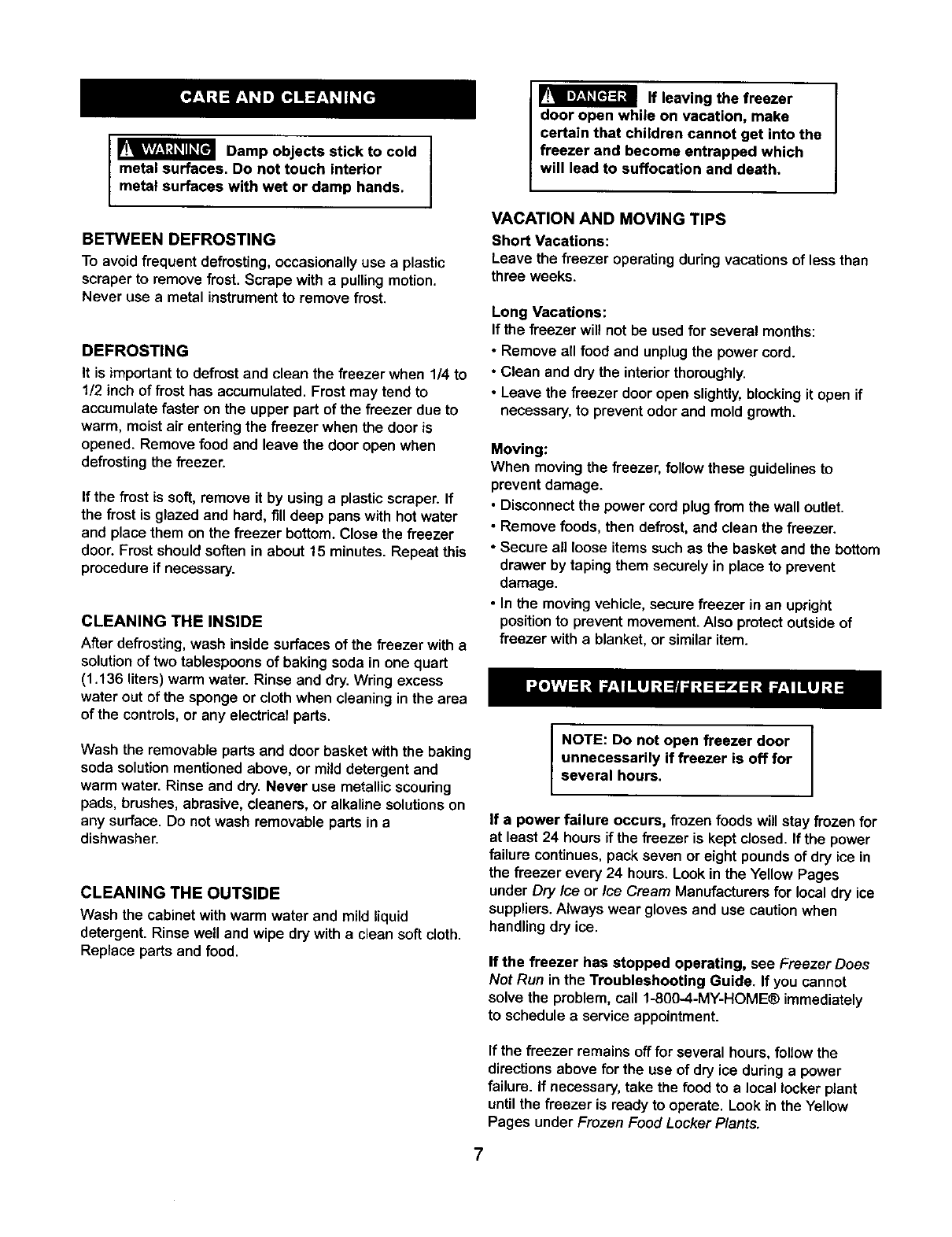
Damp objects stick to cold I
metal surfaces. Do not touch interior
I
meta surfaces w th wet or damp hands.
BETWEEN DEFROSTING
To avoid frequent defrosting, occasionally use a plastic
scraper to remove frost. Scrape with a pulling motion.
Never use a metal instrument to remove frost.
DEFROSTING
It is important to defrost and clean the freezer when 1/4 to
1/2 inch of frost has accumulated. Frost may tend to
accumulate faster on the upper part of the freezer due to
warm, moist air entedng the freezer when the door is
opened. Remove food and leave the door open when
defrosting the freezer.
If the frost is soft, remove it by using a plastic scraper. If
the frost is glazed and hard, fill deep pans with hot water
and place them on the freezer bottom. Close the freezer
door. Frost should soften in about 15 minutes. Repeat this
procedure if necessary.
CLEANING THE INSIDE
After defrosting, wash inside surfaces of the freezer with a
solution of two tablespoons of baking soda in one quart
(1.136 liters) warm water. Rinse and dry. Wring excess
water out of the sponge or cloth when cleaning in the area
of the controls, or any electrical parts.
Wash the removable parts and door basket with the baking
soda solution mentioned above, or mild detergent and
warm water. Rinse and dry. Never use metallic scoudng
pads, brushes, abrasive, cleaners, or alkaline solutions on
any surface. Do not wash removable parts in a
dishwasher.
CLEANINGTHEOUTSIDE
Wash the cabinet with warm water and mild liquid
detergent. Rinse well and wipe dry with a clean soft cloth.
Replace parts and food.
If leaving the freezer
door open while on vacation, make
certain that children cannot get into the
freezer and become entrapped which
will lead to suffocation and death.
VACATION AND MOVING TIPS
Short Vacations:
Leave the freezer operatingduringvacations of lessthan
three weeks.
Long Vacations:
If the freezer will not be used for several months:
• Remove all food and unplug the power cord.
• Clean and dry the interior thoroughly.
• Leave the freezer door open slightly, blocking it open if
necessary, to prevent odor and mold growth.
Moving:
When moving the freezer, follow these guidelines to
prevent damage.
• Disconnect the power cord plug from the wall outlet.
• Remove foods, then defrost, and clean the freezer.
• Secure all loose items such as the basket and the bottom
drawer by taping them securely in place to prevent
damage.
• In the moving vehicle, secure freezer in an upright
position to prevent movement. Also protect outside of
freezer with a blanket, or similar item.
[
NOTE: Do not open freezer door J
unnecessarily if freezer is off for
I
several hours.
If a power failure occurs, frozen foods will stay frozen for
at least 24 hoursif the freezer is kept closed. If the power
failure continues,pack seven or eightpoundsof dry ice in
the freezer every 24 hours.Lookin the Yellow Pages
under Dry Ice or Ice Cream Manufacturers for localdry ice
suppliers.Always wear glovesand use cautionwhen
handling dry ice.
If the freezer has stopped operating, see Freezer Does
Not Run in the Troubleshooting Guide. If you cannot
solve the problem,call 1-800-4-MY-HOME@ immediately
to schedulea serviceappointment.
If the freezer remains offfor several hours,follow the
directions above for the use of dry ice during a power
failure. If necessary, take the food to a local locker plant
until the freezer is ready to operate. Look in the Yellow
Pages under Frozen Food Locker Plants.
7











